David Penhallow-Scott’s final wish completed

Anna: Who Gave Her Heart to Hawaii by David Penhallow-Scott

David Penhallow-Scott

Solomon Malina and David at Kipukai c. 1939

The photo was probably taken around 1912. It has writing on it and the list of children in the picture is: left to right, front row: Mary Dorothea “Dora” Isenberg Rice, Rufus Paine Spalding, Jr., Harriet Elizabeth Rice, Alice Kauikeolani Wilcox, Samuel Whitney Wilcox II, Albert Hart Wilcox. Back row: William Allen Waterhouse, Alice Jaouen Broadbent, Leilani Rohrig, Charlotte Eileen Carter, (the handwriting says Percy Lydgate but this is probably his brother) William A. Lydgate

William Hyde Rice, as Governor of Kauai, appt. by Queen Liliuokalani

William Hyde Rice, and Kalohaiole in front of the grass house where he lived.

Judge Lyle Dickey’s hiking club, Napali Cliffs

Kalohaiole

Preparing for 50th anniversary luau of William and Mary Rice c. 1877

David Penhallow-Scott
It has been a year since David Penhallow-Scott passed away on Hawai‘i Island. The 86-year-old was a longtime resident of Kaua‘i and a wonderful friend to many. His family members have been residents of Kaua‘i for five generations and his ancestors’ contributions to the island are indelible.
It has been a year since David Penhallow-Scott passed away on Hawai‘i Island. The 86-year-old was a longtime resident of Kaua‘i and a wonderful friend to many. His family members have been residents of Kaua‘i for five generations and his ancestors’ contributions to the island are indelible.
The family names are still well-known in the islands: Rice, Wilcox, Mahelona, Cooke, King, Isenberg, Waterhouse, Lyman, and on and on. Penhallow-Scott moved to Hawai‘i Island about five years before his death, but kept strong ties with the Garden Island.
Penhallow-Scott was a theater-lover and well-established as a director, actor and playwright — “The Eudora Quartet,” “The Dark Side of the Moon,” “Listen to the Stars” and “Lights Out.” He also wrote a series of books — “After the Ball,” “The Betrayers” and “Murder with Aloha at the Coco Palms Hotel” — all of which involved (often-highly) fictionalized versions of people and events in his life. “Murder with Aloha at the Coco Palms Hotel,” for instance, included many of his memories from when he worked as a tragically-inept busboy under the stern eye of Grace Guslander during her reign at the iconic Wailua hotel.
On Hawai‘i Island, Penhallow-Scott gravitated to local theater groups and joined MAHI — Mystery Writers of Hawai‘i Island. Three members of that group, Emmeline de Pillis, myself and Leslie Karst, visited him in the hospital the day after he received the news of his terminal illness.
He was told he had about three months to live. As usual, his attitude was gracious. He acknowledged having had a full life of great adventures and many pleasures but he voiced one regret…he had not finished his latest book. He was in the process of archiving his mother’s “treasure chest” of photos and family papers, with the aim of writing a book about her, her family, and the history of Kaua‘i. Immediately, and in unison, the three women in his hospital room piped up, “We’ll do it! We’ll finish it for you.”
That was the beginning of several months spent with David. He went home. That’s where he wanted to die. Leslie and I would go to his house and sit with him as we went through musty old photo albums, boxes of diaries and family books. The pictures were often mildewed—Hilo isn’t the ideal place to archive things—and there were post-it notes stuck between pages of journals, and scratches of indecipherable writing in book margins.
It was a challenge but it was also a blessing to be able to sit with David and hear the stories he had left to tell. David had done a rough draft of the book but you have to understand one more thing: David was dyslexic.
His rough draft was a challenge to read. And as the days passed, David was steadily getting weaker and needing more pain medication. I remember one day, when he was due for another dose but was holding off until he could share a few more tidbits, that I saw beads of perspiration on his forehead.
It wasn’t a hot day. He was in pain. I went home and cried.
We sat together at his computer one day and chose the color for the book’s cover and the layout. David had already chosen a title; it would be “Anna: Who Gave Her Heart to Hawai‘i.” David thought his mother, Anna, and her family were extraordinary, and they were. But so was David. Both he and Anna were named Living Treasures by the Kaua‘i Museum.
Penhallow-Scott had hoped the book would be packed with pictures, and there are a hundred, but as the three women continued sorting through piles of material, they found that many photos had to be excluded.
Karst remembers, “They were out of focus or torn, or it was just too late…we hadn’t gotten to them in time for David to tell us who the subjects were. Marion, David’s sister, was helpful but sometimes she just didn’t know, either.”
David told me that his real intent in writing the book was to tell the stories that people have started to forget, the stories about old Kaua‘i and old Hawai‘i.
He was sad that some of the stories were already lost. He wrote, “I surely wish I’d had the courage to ask my formidable Great-aunt Daisy questions about the days when she was a young, free spirit, running barefoot with my grandmother over the sand dunes of Kipukai. I would love to have heard about her courtship and marriage to Ralph Wilcox. But (she) looked as fierce as a gargoyle and I guarantee that if I’d asked about her past with her husband Ralph, she would have slapped my head and told me flat out that it was none of my business.
As de Pillis, Karst and I, mystery-writers all, began to delve into the tales in the book, they were often surprised by the scandals, fascinating side-stories, and details of life that still did remain in the yellowed family letters.
“David said to me,” Karst remembers, “that not many things—with the exception of hemlines and hairstyles—really change over time.”
I was surprised. I had thought morals were stricter in the past. And the marriages! Somebody suggested that I make a genealogy chart to help sort out all the characters. But how do you make a chart that shows someone marrying her own uncle? Or her mother’s second husband’s brother? The chart starts to look like spaghetti.
Anna’s family was involved in many of the turning points in Hawai‘i’s history. For instance, her grandfather, William Hyde Rice, was born at Punahou School (which his parents helped to found).
Rice’s first language was Hawaiian and he carefully collected and translated into English Hawaiian legends, published by the Bishop Museum in 1923. He was the first governor of Kaua‘i, under Queen Liliuokalani, and was a close friend of other kings and queens but he also was involved peripherally with the overthrow of the kingdom.
Following the stories of Anna’s family is truly following much of the story of Hawai‘i.
“I think people all over the state will find touchstones in the book,” said de Pillis (who writes under the name Frankie Bow). “Anna lived and taught at schools throughout the islands, and influenced generations of families. Nevertheless, I imagine that Anna’s story will especially resonate with families from Kaua‘i.”
•••
“Anna: Who Gave Her Heart to Hawaii,” by David Penhallow-Scott is available at Talk Story Books in Hanapepe or from Amazon.com. According to Penhallow-Scott’s wishes, all the profits from Anna will go to scholarships in education at the University of Hawai‘i.

